Discovering the Beauty of Padparadscha Sapphire Jewelry
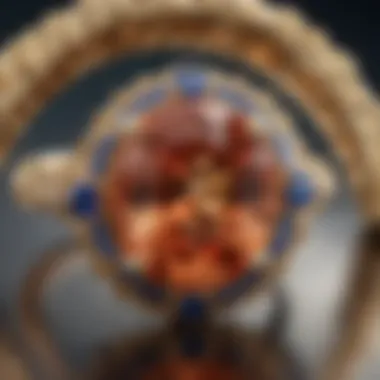

Intro
In the world of gemstones, few capture the imagination and resonate with allure as deeply as the padparadscha sapphire. Unlike your garden variety sapphires, which typically flaunt shades of blue, this stone offers a mesmerizing fusion of pink and orange tones. It's like watching the twilight sky shift colors—a rare beauty that many find difficult to resist.
The term "padparadscha" is derived from the Sinhalese word for lotus flower, and indeed, the colors of this gem mimic the subtle shades of a blooming lotus. Historically, these precious stones have woven their way through various cultures, symbolizing wealth, love, and commitment. With the steep rise in demand, the question that arises is: what makes this exquisite stone so unique, and how can one discern genuine padparadscha from imitations?
In what follows, we will dive into the intricate details surrounding these alluring gemstones, from their characteristics and classification to the chemical and physical properties that make them so distinguished. We aim to equip gemstone enthusiasts and collectors with knowledge that enriches their appreciation for padparadscha sapphire jewelry.
Gemstone Overview
Definition and characteristics
Padparadscha sapphires are a unique type of corundum, categorized by their rare combination of colors—specifically, shades of pink and orange. Unlike ordinary sapphires that exhibit one dominant hue, padparadscha stones boast a delicate balance, often reminiscent of a sunset. They usually range in color from pale orangish pink to a more vivid, deeper hue.
Their unique coloration is not only what sets them apart but also the rarity of these stones. While sapphires in general are found worldwide, padparadscha sapphires are predominantly sourced from Sri Lanka and Madagascar. Their scarcity adds to their intrigue and market value, making them a prized possession for collectors and jewelry designers alike.
Classification of gemstones
When diving into the broader landscape of gemstones, padparadscha sapphires fall beneath the larger umbrella of corundum. Here’s how they are classified:
- Natural gemstones: Formed through natural geological processes over centuries.
- Synthetic gemstones: Created in laboratories, these can mimic the appearance of natural stones.
- Imitation gemstones: Often made from glass or other materials and designed to appear similar to genuine sapphires.
Padparadscha sapphires are typically categorized as natural gemstones; however, it’s worth noting that synthetic versions do exist. Understanding this classification is vital for any collector or buyer, as it lays the foundation for appreciating the true value of what one possesses.
Properties of Gemstones
Physical properties
The physical aspects of padparadscha sapphires contribute significantly to their beauty. Their hardness, rated at 9 on the Mohs scale, makes them quite durable. Unlike some gemstones that chip and scratch easily, these stones can withstand daily wear, which is crucial for jewelry.
In terms of brilliance, they exhibit exceptional clarity and sparkle when well-cut. A well-crafted padparadscha will maximize the light reflection, akin to how sunlight glimmers off water.
Chemical properties
Chemically, padparadscha sapphires are primarily composed of aluminum oxide. However, trace elements like chromium and iron give them their distinctive color. The presence of these elements can affect the hue, saturation, and tone. This intricate dance of chemicals brings an unparalleled depth to each stone, ensuring that no two padparadscha sapphires are exactly alike.
"The unique combination of iron and chromium in padparadscha sapphires creates a captivating palette of colors that is rare in the gemstone world."
As we navigate further into the world of padparadscha sapphire jewelry, it becomes clear that understanding these properties enhances one’s ability to appreciate their allure fully. The enchanting blend of history, culture, and scientific complexity behind these stones creates a narrative that is as rich as the colors they flaunt.
Foreword to Padparadscha Sapphires
Exploring the fascinating realm of padparadscha sapphires paves the way for a deeper appreciation of its unique beauty and cultural significance. As one delves into this topic, it becomes clear that padparadscha sapphires are not just typical gemstones; they embody a blend of artistry and natural wonder that has captivated gem collectors and jewelry enthusiasts alike. This section lays the groundwork for understanding why padparadscha sapphires are considered a treasure in the realm of fine jewelry.
Definition and Description
Padparadscha sapphires are a distinctive variety of corundum, primarily characterized by their stunning blend of pink and orange hues. Unlike traditional sapphires that are typically blue, padparadscha sapphires stand out because of their captivating coloration, which often resembles the delicate shades of a sunset. The term "padparadscha" is derived from a Sinhalese word that translates to "lotus blossom," reflecting the gemstone's delicate tones resembling those of the flower.
These stones are typically more translucent than opaque, allowing light to bounce off their surfaces in mesmerizing ways. Their unique color composition, often described as a peachy pink or orangish rose, makes them all the rage among collectors searching for breathtaking alternatives to more common gemstones. But their beauty isn't just skin-deep; these sapphires carry a rich history, often considered a symbol of love and commitment, which amplifies their allure.
Origin of the Name
The name "padparadscha" has roots steeped in history and culture. As mentioned earlier, it comes from the Sinhalese word for the lotus flower, padma. This connection to nature is not merely poetic; it embodies the essence of these gemstones. For those familiar with the beauty of the lotus, you'll appreciate how this flower rises from muddy waters yet blooms in the most exquisite colors. Similarly, padparadscha sapphires emerge from the earth, showcasing colors that dazzle the eyes and stir the heart.
The history of padparadscha sapphires can be traced back to the early days of gemstone extraction in Sri Lanka, where these gemstones were first discovered. This region remains a key supplier of high-quality padparadscha stones, and the jewel's name has become synonymous with this locale. Over time, the term has evolved to encompass a standard that jewelers and collectors recognize worldwide as exceptional.
"Padparadscha sapphires aren't just stones; they are a piece of history, culture, and nature encapsulated in a single gem."
All in all, understanding both the definition and the name of padparadscha sapphires sets the stage for appreciating their unique charm and significance. The following sections will explore geological formation, color spectrum, and their cultural relevance, enriching our understanding of these precious gems.
Geological Formation of Padparadscha Sapphires
Understanding the geological formation of padparadscha sapphires is crucial for grasping what makes this gem so distinct and sought-after. These unique gemstones are not just a pretty face; their creation process is intricate and tells a story of the Earth’s geological activity. This section dives into how padparadscha sapphires are formed, their availability, and where you can find them, enriching our appreciation for their beauty and rarity.
Formation Process
Padparadscha sapphires, famous for their alluring pink-orange hue, are the result of a complex set of geological conditions. The genesis of these sapphires begins deep within the Earth’s crust. When corundum, the mineral from which sapphires are made, is subjected to high temperatures and pressures along with trace amounts of iron, titanium, and chromium, it gives rise to the striking coloration of padparadscha.
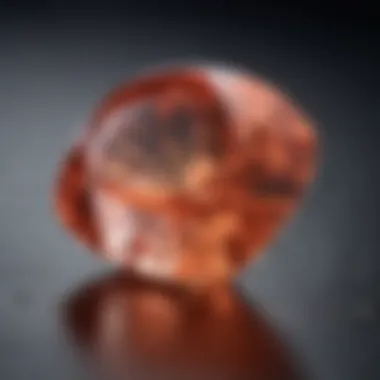
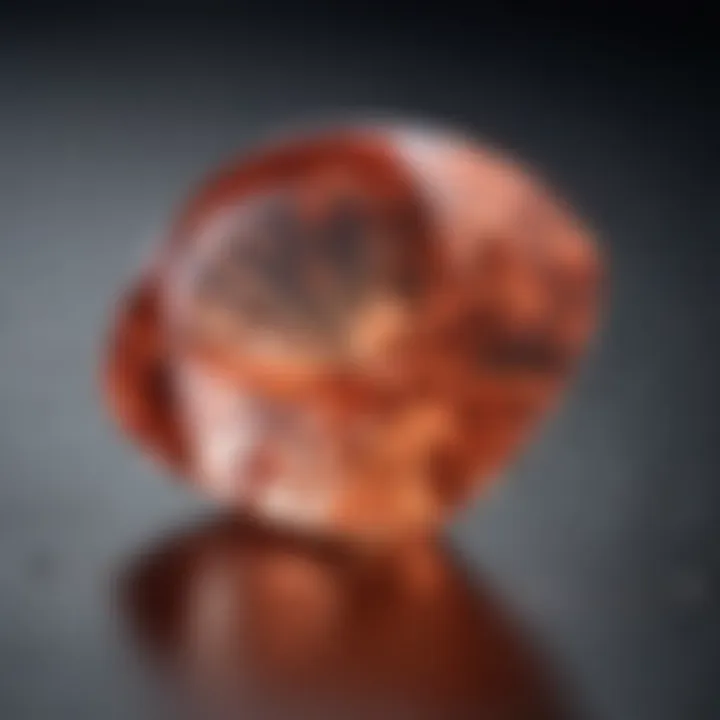
Interestingly, the specific blend of these elements is what sets padparadscha apart from classic blue sapphires. The temperature fluctuations, coupled with varying levels of these trace minerals during the crystallization process, lead to a captivating spectrum of colors. So, unlike your ordinary sapphire formed under straightforward conditions, padparadscha has an elaborate backstory, tying its existence to nature’s whims.
This formation can require millions of years, where cycles of heat and pressure build up in geological formations. These prolonged periods allow for the gradual accumulation of necessary components. Depending on the source, the exact conditions can vary, impacting the gem’s final appearance and rarity. Obtaining these gems can indeed feel like a treasure hunt, given that each stone is a unique portrait of its geological beginnings.
Availability and Sources
When it comes to availability, padparadscha sapphires are akin to finding a needle in a haystack. Most sapphires on the market these days come from countries like Sri Lanka and Madagascar, where conditions are just right for their formation. Particularly, Sri Lanka, often referred to as the land of sapphires, is renowned for producing some of the finest padparadscha gems.
Mining practices in Sri Lanka date back centuries and still continue today, with some locations being highly revered, almost sacred, for their lapidary offerings.
On the flip side, Madagascar has emerged as a significant source in the last few decades, with discoveries leading to an exciting mix of colors that have wowed collectors and jewelers alike. However, the accessibility to these gems is not always straightforward. Market dynamics combined with the fluctuating availability of quality stones means that sourcing a genuine padparadscha sapphire can sometimes feel like a gamble.
In short, the process of obtaining these sapphires isn't just a stroll in the park. It involves navigating regional markets, understanding the nuances of miners' practices, and sometimes relying on connections in distant lands. Gemstone enthusiasts often find themselves chasing down leads and exploring new suppliers, especially as demand grows in both jewelry and investment markets.
"The rarity of padparadscha sapphires makes them not just a purchase but an investment in nature's art."
With the awareness of their formation process and sources, collectors can better appreciate the inherent value of these gemstones, recognizing that each one carries a piece of the Earth’s history within it.
Color Spectrum and Characteristics
The world of gemstones is vast and varied, yet few capture attention quite like the padparadscha sapphire. The color spectrum and characteristics of this stone are not just important; they are the very elements that define its allure. Different hues can evoke a range of emotions and interpretations, making understanding them essential for potential buyers, collectors, and jewelry makers.
When we talk about color in gemstones, especially in regards to padparadscha sapphires, we dive deep into a blend of pink and orange tones. These colors result not from simple pigmentation but rather a mix that can convey warmth and vibrancy, each tone telling a different story to an observer. Furthermore, the characteristics associated with these hues can influence the attractiveness and market value of the stone. This section sheds light on why color is such a critical aspect of the padparadscha sapphire and the factors that contribute to its visual identity.
Understanding Pink and Orange Hues
The pink and orange hues of padparadscha sapphires are nothing short of mesmerizing. At first glance, they might seem like any run-of-the-mill gemstone, but upon closer inspection, one can appreciate the intricate play of colors. The ideal padparadscha sapphire exhibits a unique balance between these two colors. Too much pink can overshadow the vibrant oranges, while excessive orange might dull the freshness of the pink.
"A well-balanced padparadscha sapphire can dazzle just as much under candlelight as it does in the clear midday sun, revealing its true beauty with each change in light."
Here are a few noteworthy points about the color attributes of these gems:
- Color Classification: The gem's color can range from a pale blush pink to a rich sunset orange, sometimes even showcasing shades that lean more towards peach. The more balanced the blend between pink and orange, the more valuable the stone is likely to be.
- Rarity of Pure Hues: Pure hues are rare. For instance, if you come across a stone that is predominantly orange or pink, it may often fall short of the true padparadscha category.
- Gemstone Quality: The intensity of a stone's hue can also reflect its quality, with well-saturated colors being more sought after. A vibrant stone can allure collectors and enthusiasts alike.
Factors Affecting Color Variations
Various factors play a role in the color variations observed in padparadscha sapphires. Understanding these elements can help potential buyers make informed decisions. The significant ones include:
- Geological Conditions: The geological milieu where a sapphire undergoes formation can substantially affect its coloration. Mineral compositions during crystallization can lead to distinct hues.
- Lighting Conditions: The way light interacts with the sapphire can shift its colors. Viewing the gemstone under different lighting can reveal hidden nuances that may go unnoticed.
- Heat Treatment: Some sapphires may undergo heating processes to enhance their colors. This treatment can deepen shades but may also diminish their natural character. It’s important to be aware of how treatments have affected the gem.
In summary, grasping the color spectrum and characteristics of padparadscha sapphires reveals much about their allure. The subtle interplay between pink and orange hues, coupled with the factors influencing these colors, adds layers to their appreciation. Collectors and enthusiasts should delve into these intricacies, ensuring they choose a stone that is not just beautiful but resonates with their personal aesthetic and emotional connection.
Cultural Significance of Padparadscha Sapphires
Padparadscha sapphires hold a unique cherished spot in various cultures around the globe. Their distinct hues, blending shades of pink and orange, have made them not merely gemstones but symbols of deeper meanings and connections. The allure of padparadscha sapphires transcends their physical beauty, embedding them in the narratives of heritage and civilization.
Historical Uses in Jewelry
The history of padparadscha sapphires in jewelry is rich and colourful. Used in creations for centuries, these gems can often be found in royal adornments, worn by those of high status. One notable example is the stunning pieces crafted for the rulers of ancient Sri Lanka, the birth and main source of these stones. These jewels were said to bring power and prestige, adorned in settings that promised their wearers divine protection.
In more modern contexts, padparadscha sapphires have found favor among contemporary jewelers, who appreciate their rarity and distinctive hues. Designers often use these stones in engagement rings and other meaningful pieces, symbolizing love with their blend of warmth and elegance. The historical applications of padparadscha sapphires in grand designs of both past and present show a deep-rooted admiration for this unique gemstone.
Symbolism and Beliefs
Beyond their physical characteristics, padparadscha sapphires carry significant symbolic weight as well. In many cultures, these sapphires are believed to embody harmony and balance. The vibrant colors are associated with nurturing qualities, representing compassion and warmth. Furthermore, the orange-pink mix of the padparadscha evokes feelings of joy, making it a popular choice for celebratory occasions.
Many enthusiasts believe that wearing padparadscha sapphires can lead to improved emotional well-being, cultivating patience and stability in turbulent times. This cultural perception is heightened in Buddhist traditions, where these gemstones are often seen as symbols of enlightenment. Jewelry adorned with padparadscha sapphires may not just be a fashionable accessory; instead, it can become a manifestation of spiritual aspirations.
"Padparadscha sapphires embody a rich tapestry of cultural beliefs and societal values, connecting those who wear them to their history and heritage."
Thus, the cultural significance of padparadscha sapphires goes beyond aesthetics. They weave together stories of power, love, joy, and serenity, enriching the narrative of personal identity and cultural legacy.
Market Trends and Demand
Understanding the market trends and demand for padparadscha sapphires is essential for enthusiasts and collectors alike. This unique gemstone has captured the hearts of many due to its rare color and stunning beauty. The increasing interest in ethical sourcing and sustainable options is shaping how these gemstones are sought after in the market today.
The allure of padparadscha sapphires extends beyond their aesthetic appeal; they also represent a sound investment for collectors. As demand grows, so do the considerations around authenticity, quality, and market volatility. Thus, it's timely to dive into how market prices are fluctuating and what it means for investment potential.
Current Market Prices
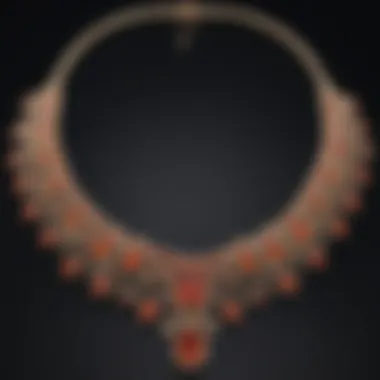
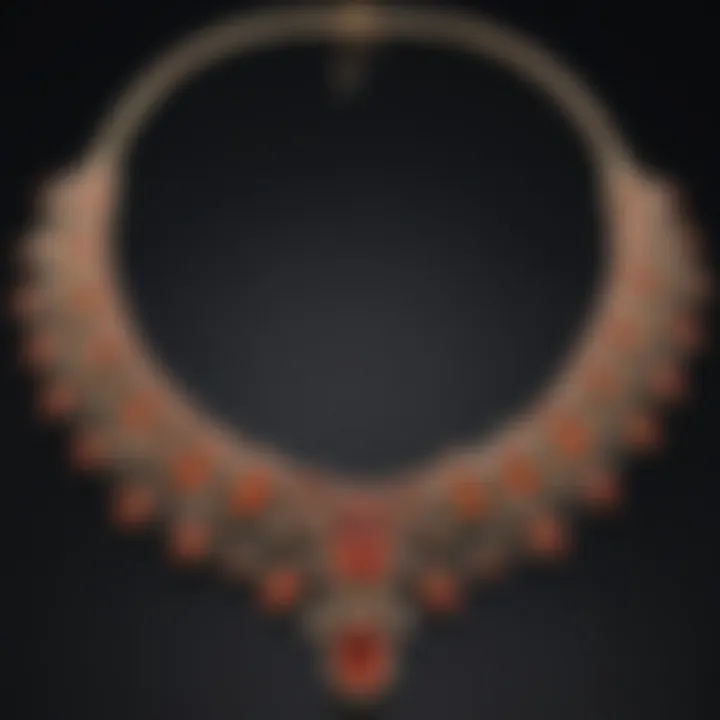
Market prices for padparadscha sapphires can vary widely, influenced by factors such as color saturation, clarity, and size. As of now, prices often range from a few hundred dollars per carat to upwards of a thousand or more for exceptional specimens.
Here are some key elements influencing current prices:
- Quality Factors: The most significant determinant is the gemstone’s quality. Vibrant pink and orange hues are more coveted, leading to higher prices.
- Size Matters: Larger stones are rarer and thus can command a premium.
- Origin: Stones sourced from Sri Lanka or Madagascar are often viewed as more desirable, affecting their market value.
"The rarity of perfect padparadscha sapphires can turn a collector's item into a precious heirloom with increasing value over time."
As more collectors enter the market, the prices continue to rise, making it crucial for potential buyers to stay informed about trends and price shifts.
Investment Potential
Investing in padparadscha sapphires may seem daunting, but with the right information, it can be quite rewarding. The increasing global demand reflects broader trends towards unique, one-of-a-kind investments in the luxury goods sector.
Several aspects bolster the investment potential of these sapphires:
- Rarity: The rarity of top-tier padparadscha sapphires ensures a more stable investment. As fewer are mined, their value tends to appreciate over time.
- Cultural Relevance: Their growing popularity in contemporary jewelry designs adds to their appeal among trendsetters and collectors.
- Long-term Value: The historical significance and connection to cultural heritage can lead to a strong long-term investment appeal.
Choosing Genuine Padparadscha Sapphires
Key Identification Features
When it comes to identifying genuine padparadscha sapphires, certain distinctive characteristics can aid buyers in making informed decisions. Here are a few key features to look for:
- Color: True padparadscha sapphires exhibit a harmonious blend of pink and orange hues. The color should not be too vibrant or overly subdued. Instead, it is often described as delicate and soothing—a pastel sort of vibe.
- Clarity: Natural padparadscha sapphires typically possess some inclusions. However, avoid stones that are overly cloudy or filled with visible inclusions. A gemstone with a moderate number of inclusions might actually amplify its character without compromising beauty.
- Cut: The quality of the cut can significantly influence the stone’s appearance. A well-cut padparadscha will reflect light beautifully, enhancing its color dynamics. Look for a symmetrical shape and smooth facets.
- Carat Weight: Most padparadscha sapphires are rare, especially in larger carat weights. If a stone is available in a considerable size at a surprisingly low price, it might raise suspicion.
These features serve as a guideline to ensure that one is not easily swayed by the surface allure of a fake or treated gemstone.
Certification and Appraisal
Moving beyond the visual clues, procuring a certified padparadscha sapphire is essential. Certification from reputable gemological organizations, such as the Gemological Institute of America or the International Gemological Institute, provides necessary assurance regarding the stone’s authenticity. Here’s why focusing on certification is crucial:
- Trustworthiness: Certified stones come with detailed reports that outline the identification features, grading, and sometimes the origin of the sapphire. This gives collectors and enthusiasts a sense of security.
- Value Appraisal: A certified gemstone holds its value better in the marketplace. This means that should you ever wish to resell, the certified stone is more likely to attract serious buyers at a fair price.
- Avoiding Misrepresentation: In a market where marketing claims often kindle confusion, certification offers clarity. It protects consumers from misrepresented items, ensuring that the stone sold as a padparadscha sapphire indeed qualifies as one.
In summary, choosing genuine padparadscha sapphires necessitates a keen eye coupled with a focus on certification. Understanding and assessing the key identification features will lead to more informed and satisfactory purchases.
"Well-informed buyers are like seasoned sailors navigating through stormy seas—they’ll reach the harbor safely."
By establishing the authenticity of your sought-after sapphire, not only do you enrich your collection, but you also engage with the timeless beauty and heritage embodied by genuine padparadscha sapphires.
Caring for Padparadscha Sapphire Jewelry
Taking care of padparadscha sapphire jewelry is crucial for preserving its beauty and vibrancy. This gemstone, unique in its blend of pink and orange shades, requires more than just a casual glance; it demands a respectful approach to maintenance. After all, one misstep can lead to scratches on its surface or even worse, permanent damage. Proper care ensures not only the longevity of the piece but also fortifies its brilliance against the everyday wear and tear that comes with life.
Cleaning and Maintenance
Regular cleaning is vital to keep your padparadscha sapphire jewelry looking its best. Dust, dirt, and oils from your skin can accumulate, dulling the striking hues. To clean these pieces, use a gentle touch.
- Soak the jewelry in a solution of lukewarm water and mild soap for about 15 to 20 minutes.
- Brush it gently with a soft toothbrush or a cloth, paying extra attention to the crevices where grime tends to hide.
- Rinse with clean water and dry it softly with a lint-free cloth.
A few reminders:
- Avoid using abrasive materials or harsh chemicals that could scratch or damage the stone.
- For deeply set stones or intricate designs, consider professional cleaning every now and then.
"A little care goes a long way; taking the time to clean your gems can save you from costly repairs!"
Safe Storage Practices
When not wearing your padparadscha sapphire jewelry, the way you store it plays a key role in prolonging its life. A safe environment can prevent scratches, chips, and other wear that can easily occur.
To ensure your jewelry remains in prime condition, consider the following:
- Individual compartments: Store each piece in its own soft pouch or compartment in a jewelry box. This will keep them from contacting each other and help avoid scratches.
- Avoid extremes: Steer clear from placing your jewelry in places that may experience extreme temperatures or humidity.
- Out of sun’s reach: Sunlight can fade the colors of your padparadscha over time, so keep it in a shaded area when not in use.
By adhering to these simple cleaning and storage guidelines, you're not just taking care of an item; you're caring for a piece of art, a slice of nature's beauty, and perhaps, even a family heirloom.
Padparadscha Sapphires in Famous Jewelry Pieces
Padparadscha sapphires have a captivating allure that transcends mere aesthetics. Their unique blend of pink and orange hues makes them highly sought after by jewelry aficionados and collectors alike. These gems are not only prized for their rarity but also for their storied presence in exquisite jewelry pieces through the ages. The significance of padparadscha sapphires in notable artifacts and modern adornments highlights their enduring value and appeal.
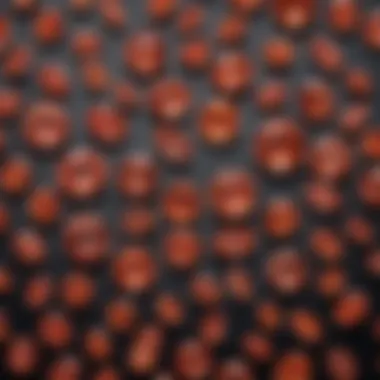

Notable Historical Artifacts
Throughout history, padparadscha sapphires have adorned crowns, necklaces, and rings, often entwined with royal tales and cultural heritage. For instance, the Queen Maria of Romania was known for her spectacular collection which featured a stunning padparadscha sapphire brooch that became a symbol of elegance. Exhibits at prestigious museums display rings and earrings with these sapphires, reminding us of their historical importance. Their inclusion in royal regalia signifies not just wealth but a deeper cultural significance.
Moreover, ancient manuscripts mention the use of padparadscha sapphires in ceremonial jewelry utilized in spiritual rituals, particularly in Southeast Asia. The gemstones were believed to possess protective properties, making them an essential element in royal treasuries and religious artifacts alike. Even to this day, some of these artifacts tell the remarkable story of explorations of gem traders and their conquests.
Celebrity Adornments
In contemporary times, padparadscha sapphires continue to capture the attention of the elite. Many celebrities opt for these unique gems as a means to stand out in a crowd. For example, Princess Eugenie of York wore a stunning padparadscha sapphire engagement ring, which was both a nod to tradition and a beacon of modern elegance. Its distinctive color helped forge a narrative that is uniquely hers, elevating her personal style.
Additionally, Hollywood stars often adorn themselves with padparadscha sapphire jewelry during prestigious events. The blend of its colors often complements various outfits, making it a favorite among stylists. Designers integrate this stone into various pieces, from statement necklaces to delicate earrings, showcasing its versatility and charm.
"In the world of gemstones, the rarity and beauty of padparadscha sapphires continuously revolutionize how we perceive and appreciate jewelry design."
The stories behind both historical artifacts and modern celebrity selections reveal a clear appreciation for padparadscha sapphires. As these gems transition from royal courts to the red carpet, they maintain a firm grasp on what it means to be rare and beautiful, cementing their place in jewelry history.
Padparadscha Sapphires in Modern Design
Contemporary Jewelry Trends
Recent years have seen a notable shift in jewelry preferences, with consumers increasingly drawn to colored gemstones rather than traditional diamonds. Padparadscha sapphires, with their mesmerizing shades, naturally fit into this narrative. Designers have begun to incorporate them into more modern and innovative pieces, steering away from the more conventional settings.
The color of padparadscha sapphires lends itself to unique pairings; they look stunning when combined with metals such as rose gold and white gold. This has led to pieces that don't just showcase the gemstone but use it as a central element in the design. From asymmetric earrings to stacked rings, the styling possibilities are endless. Moreover, jewelry enthusiasts are embracing personalized pieces, and padparadscha sapphires serve as an excellent choice for meaningful engagement rings or heirloom jewelry.
Some trends making waves include:
- Mixed Metal Designs: Combining gold, silver, and unique gemstones.
- Nature-Inspired Themes: Floral designs that highlight the organic beauty of this stone.
- Layered Jewelry: Incorporating padparadscha sapphires into layered necklaces or stacked rings to create a stunning focal point.
Artisans and Designers
Artists and designers are increasingly seeking the padparadscha sapphire for its ability to evoke strong emotional responses while showcasing expert craftsmanship. Not only does it reflect the artistry of design, but the stone also tells a story—one of nature's beauty and geological rarity. Independent jewelers and renowned designers alike are tapping into the charm of padparadscha sapphires, pushing the boundaries of traditional jewelry design.
Collaboration across creative fields has also become more commonplace. Some designers are joining forces with gemologists ensure that these stunning stones are not only beautifully set but ethically sourced as well. Such partnerships reinforce the commitment to quality and sustainability, which is becoming an important consideration among modern consumers.
The unique qualities of padparadscha sapphires are now influencing:
- Custom Designs: Many artisans offer bespoke options, allowing customers to choose settings that truly reflect their personal style.
- Limited Edition Collections: Smaller production runs highlight the exclusivity of the stones, attracting collectors interested in unique pieces.
- Social Media Visibility: Designers utilize platforms like Instagram and Pinterest to showcase their work, further elevating the presence of padparadscha sapphires in the market.
"The beauty of padparadscha sapphires goes beyond their appearance; they are a blend of nature and design, rooted deeply in luxury and individual expression."
The future looks bright for both padparadscha sapphires and the artisans who choose to work with them. As trends shift towards valuing authenticity and character, these captivating gemstones are sure to maintain a prominent role in modern jewelry design.
The Future of Padparadscha Sapphire Jewelry
As the gemological world continues to evolve, the future of padparadscha sapphire jewelry holds promising avenues for both enthusiasts and collectors alike. Not only does this fascinating gemstone capture the imagination with its rare coloring that dances between delicate pink and warm orange hues, but it also signifies a growing movement towards sustainability and ethical practices within the jewelry industry. This section aims to highlight the key elements influencing the future of padparadscha sapphires, focusing specifically on sustainability and emerging trends in gemological exploration.
Sustainability and Ethical Sourcing
The importance of sustainability and ethical sourcing in the context of padparadscha sapphires cannot be overstated. As consumers grow increasingly aware of environmental concerns and social issues, the demand for ethically sourced gems is on the rise. Here are several key points to consider:
- Environmental Impact: Traditional mining methods often lead to habitat destruction and pollution. However, ethical sourcing practices aim to minimize these impacts, ensuring that mining operations adhere to strict environmental standards.
- Fair Trade Practices: Many jewelers now seek suppliers who engage in fair trade practices. This means that miners and workers receive fair wages and favorable working conditions. Supporting these practices enhances the overall value of padparadscha sapphire jewelry, aligning it with consumers' values.
- Traceability: With advancements in technology, traceability of gemstones has become more feasible. Consumers can now verify the origins of their sapphires, ensuring they come from sustainable and responsible sources.
- Eco-Friendly Treatments: As the industry evolves, there is a growing tendency to utilize eco-friendly methods in the treatment and enhancement of sapphires. This not only maintains the gemstone's beauty but also reduces harmful chemical use.
In short, the future of padparadscha sapphire jewelry is intertwined with sustainability principles, making it more appealing to today's conscientious buyer.
Potential Developments in Gemology
The field of gemology itself is not static; it's constantly advancing with innovative technologies and methodologies that could change how we understand and appreciate padparadscha sapphires. A few potential developments include:
- Advanced Spectroscopy: Improved spectroscopic techniques may enable gemologists to analyze color variations more precisely. This allows for greater understanding of the nuances that give padparadscha sapphires their distinctive appearance.
- Laboratory-Grown Alternatives: As with many other gemstones, laboratory-grown padparadscha sapphires may become more prevalent. While some purists may shy away from these creations, they offer a sustainable alternative that appeals to eco-conscious consumers.
- Blockchain Technology: The application of blockchain in tracing gemstone origins could further ensure transparency in the industry. This tech might empower consumers with reliable information that confirms ethical sourcing and authenticity, elevating confidence in purchasing decisions.
- Research on Color Enhancement: Ongoing research into natural treatments that enhance colors while preserving ethical standards may lead to more brilliant and vivid padparadscha sapphires.
These advances showcase the dynamic nature of the gemological field and suggest that padparadscha sapphires will continue to capture interest for years to come.
Ending
The conclusion of this article serves as a vital synthesis of all the knowledge gathered about padparadscha sapphires, a gemstone that catches the eye and heart alike. Through this journey, we've traversed the paths of geological formation, historical significance, and market trends, uncovering just what makes padparadscha sapphires special. They aren’t just beautiful stones; they hold rich stories, cultural relevance, and financial potential.
Embracing the Unique Qualities of Padparadscha Sapphires
In appreciating padparadscha sapphires, one can't overlook the remarkable attributes they bring to both collectors and casual admirers. These sapphires, with their rare fusion of pink and orange hues, appear almost ethereal under the right lighting. It’s these shades that evoke feelings, turning jewelry into expressions of individuality and elegance.
- Exceptional Color: The semi-precious stone’s unique coloring results from trace elements found within the sapphire—a marvel of nature’s artistry. Collectors often seek these hues for their finite availability.
- Historical Significance: Historically, they signify marriage and commitment, making them popular in engagement rings. Using them as an emblem of love adds layers of meaning to any piece of jewelry.
- Market Potential: As their rarity continues to grow, investing in padparadscha sapphires can yield promising returns in the long run. This rising demand underlines their allure, not just as items of beauty but as intelligent investments.
Padparadscha sapphires are indeed masterful creations of nature, demanding attention for both their physical beauty and the stories that surround them.
So as you wear or gift a piece of padparadscha sapphire jewelry, know that it carries not just the vibrancy of color but a rich history, an investment in beauty and culture, that transcends mere aesthetics.



